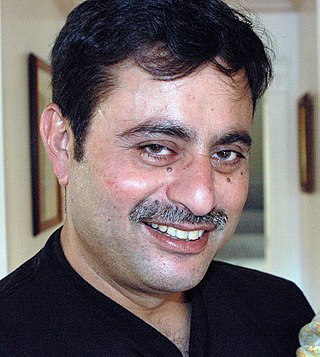
In formal language theory, a context-free grammar (CFG) is a formal grammar whose production rules can be applied to a nonterminal symbol regardless of its context. In particular, in a context-free grammar, each production rule is of the form
In formal language theory, a context-free language (CFL) is a language generated by a context-free grammar (CFG).
In formal language theory, a context-free grammar, G, is said to be in Chomsky normal form if all of its production rules are of the form:

A finite-state machine (FSM) or finite-state automaton, finite automaton, or simply a state machine, is a mathematical model of computation. It is an abstract machine that can be in exactly one of a finite number of states at any given time. The FSM can change from one state to another in response to some inputs; the change from one state to another is called a transition. An FSM is defined by a list of its states, its initial state, and the inputs that trigger each transition. Finite-state machines are of two types—deterministic finite-state machines and non-deterministic finite-state machines. A deterministic finite-state machine can be constructed equivalent to any non-deterministic one.
In theoretical computer science and formal language theory, a regular language is a formal language that can be defined by a regular expression, in the strict sense in theoretical computer science.
In theoretical computer science and formal language theory, a regular grammar is a grammar that is right-regular or left-regular. While their exact definition varies from textbook to textbook, they all require that

In theoretical computer science and mathematics, the theory of computation is the branch that deals with what problems can be solved on a model of computation, using an algorithm, how efficiently they can be solved or to what degree. The field is divided into three major branches: automata theory and formal languages, computability theory, and computational complexity theory, which are linked by the question: "What are the fundamental capabilities and limitations of computers?".
Alfred Vaino Aho is a Canadian computer scientist best known for his work on programming languages, compilers, and related algorithms, and his textbooks on the art and science of computer programming.

John Edward Hopcroft is an American theoretical computer scientist. His textbooks on theory of computation and data structures are regarded as standards in their fields. He is the IBM Professor of Engineering and Applied Mathematics in Computer Science at Cornell University, Co-Director of the Center on Frontiers of Computing Studies at Peking University, and the Director of the John Hopcroft Center for Computer Science at Shanghai Jiao Tong University.
In theoretical computer science, a discrete system is a system with a countable number of states. Discrete systems may be contrasted with continuous systems, which may also be called analog systems. A final discrete system is often modeled with a directed graph and is analyzed for correctness and complexity according to computational theory. Because discrete systems have a countable number of states, they may be described in precise mathematical models.
In computer science, an ambiguous grammar is a context-free grammar for which there exists a string that can have more than one leftmost derivation or parse tree. Every non-empty context-free language admits an ambiguous grammar by introducing e.g. a duplicate rule. A language that only admits ambiguous grammars is called an inherently ambiguous language. Deterministic context-free grammars are always unambiguous, and are an important subclass of unambiguous grammars; there are non-deterministic unambiguous grammars, however.
Jeffrey David Ullman is an American computer scientist and the Stanford W. Ascherman Professor of Engineering, Emeritus, at Stanford University. His textbooks on compilers, theory of computation, data structures, and databases are regarded as standards in their fields. He and his long-time collaborator Alfred Aho are the recipients of the 2020 Turing Award, generally recognized as the highest distinction in computer science.
In computer science, a linear grammar is a context-free grammar that has at most one nonterminal in the right-hand side of each of its productions.
Indexed languages are a class of formal languages discovered by Alfred Aho; they are described by indexed grammars and can be recognized by nested stack automata.
In formal language theory, deterministic context-free languages (DCFL) are a proper subset of context-free languages. They are the context-free languages that can be accepted by a deterministic pushdown automaton. DCFLs are always unambiguous, meaning that they admit an unambiguous grammar. There are non-deterministic unambiguous CFLs, so DCFLs form a proper subset of unambiguous CFLs.

Rajeev Motwani was an Indian American professor of Computer Science at Stanford University whose research focused on theoretical computer science. He was a special advisor to Sequoia Capital. He was a winner of the Gödel Prize in 2001.

In automata theory, DFA minimization is the task of transforming a given deterministic finite automaton (DFA) into an equivalent DFA that has a minimum number of states. Here, two DFAs are called equivalent if they recognize the same regular language. Several different algorithms accomplishing this task are known and described in standard textbooks on automata theory.

In computer science, more particular in the theory of formal languages, a counter automaton, or counter machine, is a pushdown automaton with only two symbols, and the initial symbol in , the finite set of stack symbols.
In formal language theory and pattern matching, alternation is the union of two sets of strings, or equivalently the logical disjunction of two patterns describing sets of strings.
The union theorem is a result from the 60s in computational complexity theory. It was published in 1969 by Ed McCreight and Albert Meyer.








